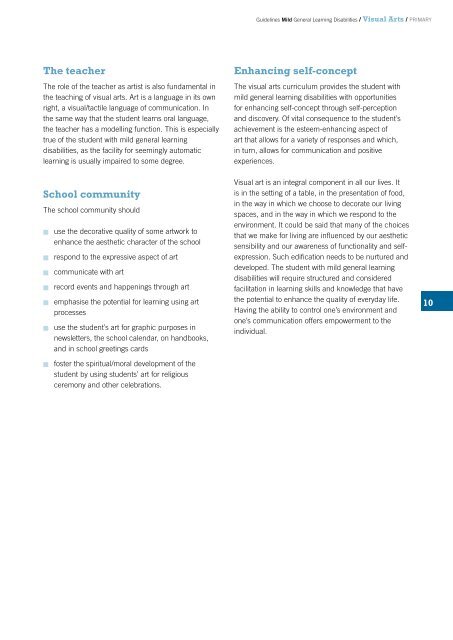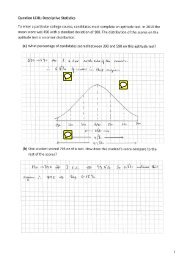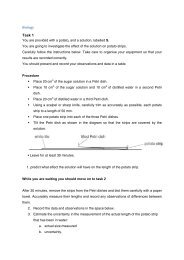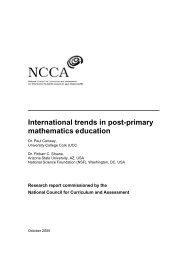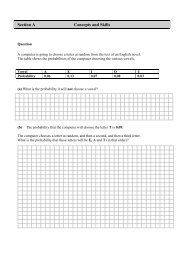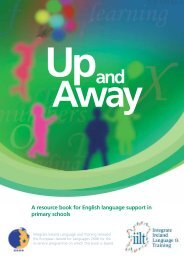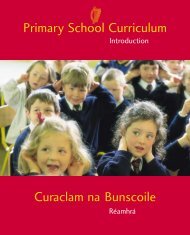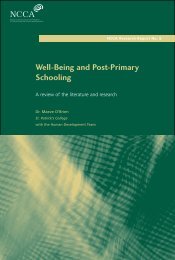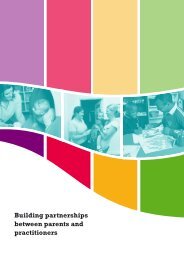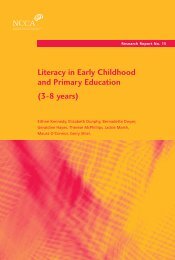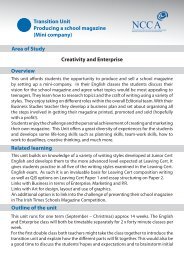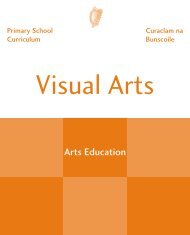Visual Arts - NCCA
Visual Arts - NCCA
Visual Arts - NCCA
Create successful ePaper yourself
Turn your PDF publications into a flip-book with our unique Google optimized e-Paper software.
The teacher<br />
The role of the teacher as artist is also fundamental in<br />
the teaching of visual arts. Art is a language in its own<br />
right, a visual/tactile language of communication. In<br />
the same way that the student learns oral language,<br />
the teacher has a modelling function. This is especially<br />
true of the student with mild general learning<br />
disabilities, as the facility for seemingly automatic<br />
learning is usually impaired to some degree.<br />
School community<br />
The school community should<br />
n<br />
n<br />
n<br />
n<br />
n<br />
n<br />
n<br />
use the decorative quality of some artwork to<br />
enhance the aesthetic character of the school<br />
respond to the expressive aspect of art<br />
communicate with art<br />
record events and happenings through art<br />
emphasise the potential for learning using art<br />
processes<br />
use the student’s art for graphic purposes in<br />
newsletters, the school calendar, on handbooks,<br />
and in school greetings cards<br />
foster the spiritual/moral development of the<br />
student by using students’ art for religious<br />
ceremony and other celebrations.<br />
Guidelines Mild General Learning Disabilities / <strong>Visual</strong> <strong>Arts</strong> / PRIMARY<br />
Enhancing self-concept<br />
The visual arts curriculum provides the student with<br />
mild general learning disabilities with opportunities<br />
for enhancing self-concept through self-perception<br />
and discovery. Of vital consequence to the student’s<br />
achievement is the esteem-enhancing aspect of<br />
art that allows for a variety of responses and which,<br />
in turn, allows for communication and positive<br />
experiences.<br />
<strong>Visual</strong> art is an integral component in all our lives. It<br />
is in the setting of a table, in the presentation of food,<br />
in the way in which we choose to decorate our living<br />
spaces, and in the way in which we respond to the<br />
environment. It could be said that many of the choices<br />
that we make for living are influenced by our aesthetic<br />
sensibility and our awareness of functionality and selfexpression.<br />
Such edification needs to be nurtured and<br />
developed. The student with mild general learning<br />
disabilities will require structured and considered<br />
facilitation in learning skills and knowledge that have<br />
the potential to enhance the quality of everyday life.<br />
Having the ability to control one’s environment and<br />
one’s communication offers empowerment to the<br />
individual.<br />
10


